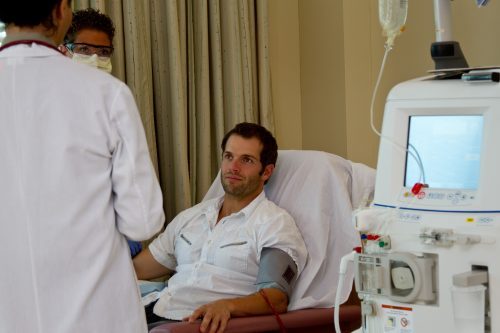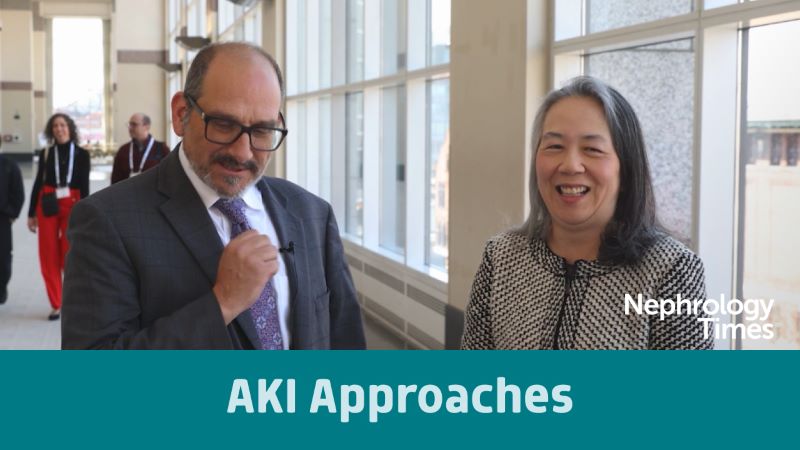
Among patients undergoing coronary angiography or percutaneous coronary intervention (PCI), between 4% and 10% experience acute kidney injury (AKI). The costs of care in the United States attributed to AKI in that patient population has been estimated as high as $1.67 billion annually. AKI is associated with adverse renal and cardiovascular adverse outcomes, including acute dialysis, end-stage renal disease, heart failure, atherosclerotic events, and death.
According to Matthew T. James, MD, PhD, and colleagues, uptake of the recommended strategies for care to avoid contrast-associated AKI during those procedures varies. The researchers conducted a stepped-wedge, cluster randomized clinical trial to determine whether a multifaceted intervention would be effective to prevent AKI after coronary angiography or PCI. Results were reported in JAMA [2022;328(9):839-849].
All invasive cardiologists at three cardiac catheterization laboratories in Alberta, Canada, were randomized to one of eight start dates for the intervention between January 2018, and September 2019. The intervention included three components: (1) educational outreach that included information about AKI, prevention approaches, and the components of the intervention; (2) computerized clinical decision support on contrast volume and hemodynamic-guided intravenous fluid targets; and (3) audit and feedback every 3 months following initial introduction to the intervention. During the preintervention period (control), the cardiologists provided usual care and did not receive the intervention.
The primary outcome of interest was AKI defined by serum creatinine-based criteria form the Kidney Disease: Improving Global Outcomes AKI guidelines. Secondary outcomes included contrast volume, intravenous fluid administration, and major adverse cardiovascular and kidney events. Time-adjusted models were used in all analyses.
Of the 34 invasive cardiologists who contributed data to the trial, three retired from practice before receiving the intervention and contributed data only to the control group (preintervention period). Of the 31 physicians who received the intervention as planned, 12.9% (n=4) were women, mean age was 51.2 years, and mean length of practice was 19.6 years. During the study period, a total of 29 418 coronary angiography or PCI procedures were performed in 26 110 patients.
Following exclusion of 19 004 patients undergoing dialysis, urgent primary PCI for ST-segment elevation myocardial infarction, and those with less than a 5% risk of AKI, a total of 7820 procedures in 7106 patients were eligible for inclusion in the analysis. Of the 7820 procedures, 4327 were performed by the 31 cardiologists in the intervention group among 4032 patients (mean age, 70.3 years; 32.0% [n=1384) women). The remaining 3493 procedures were performed by the 34 cardiologists in the control group among 3251 patients (mean age, 70.2 years; 33.0% [n=1151) women). Of total procedures, 10.2% (n=794) were missing data for the primary outcome and 8.9% (n=698) were missing data on contrast volume.
During the intervention period, the range of the number of procedures performed by each physician among patients with a more than 5% risk of AKI across the 31 physicians was from 4 to 334 (median, 130 procedures per physician); during the control period, the range across the 34 physicians was from 22 to 325 (median, 87 procedures per physician). There were small differences in procedure indication between the intervention group and the control group. The two groups were similar in patient demographic characteristics, comorbidities, preprocedure estimated glomerular filtration rate (eGFR), predicted risk of AKI, and fluoroscopy time (a surrogate of procedure complexity).
Primary Outcome
During the 2-year study period, there were 310 AKI events after 4327 procedures (7.2%) performed by physicians in the intervention group compared with 299 AKI events after 3493 procedures (8.6%) performed by physicians in the control group (between group difference, –2.3% [95% CI, –0.6% to –4.1%]). In the primary analysis accounting for clustering and adjustment for time, the intervention resulted in a significant odds reduction in AKI (time-adjusted odds ratio [OR], 0.72; 95% CI, 0.56 to 0.93; P=.01). There was a consistent effect over the duration of the trial (P=.27 for treatment × time interaction).
In multivariable analyses with additional adjustments for age, sex, comorbidities, eGFR, and procedure indication, results were similar (adjusted OR, 0.67; 95% CI, 0.52-0.86), and in the complete case analysis. In subgroups defined by age, sex, with or without heart failure or CKD, at moderate or high risk of AKI, and in patients who underwent coronary angiography alone or procedures including PCI, the effect was seen consistently. The effect was also seen consistently when alternate serum creatinine-based definitions for AKI were assessed. In a post hoc analysis following exclusion of data from the three physicians who retired before receiving the intervention, the results remained consistent.
Secondary Outcomes
Of the 12 prespecified secondary outcomes, eight showed no significant difference. The proportion of procedures using excessive contrast volumes was reduced from 51.7% during the control period to 38.1% during the intervention period (between-group difference, –12.0%; 95% CI, –14.4% to –9.4%; time-adjusted OR, 0.77; 95% CI, 0.65 to 0.90; P=.002). The proportion of procedures in eligible patients in whom insufficient intravenous fluid was given was reduced from 75.1% during the control period to 60.8% during the intervention period (between-group difference, –15.8%; 95% CI, –19.7% to –12.0%; OR, 0.68; 95% CI, 0.53 to 0.87; P=.002). There were no significant between-group differences in major adverse cardiovascular events or major adverse kidney events.
The researchers cited several limitations to the study, including the cluster randomized clinical trial design that may have lower risk of bias than nonrandomized designs, the vulnerability of the stepped-wedge design to contamination if the physicians who had not yet received the intervention were aware of the trial and changed their behaviors prior to receiving the intervention, 10.2% of the cohort having missing data for AKI, the relatively small number of physician clusters, and the possibility that the findings may not be generalizable to countries other than Canada.
In conclusion, the researchers said, “Among cardiologists randomized to an intervention including clinical decision support with audit and feedback, patients undergoing coronary procedures during the intervention period were less likely to develop AKI compared with those treated during the control period, with a time-adjusted absolute risk reduction of 2.3%. Whether this intervention would show efficacy outside this study setting requires further investigation.”
Takeaway Points
- Contrast-associated Acute kidney injury (AKI) is a common complication of coronary angiography and percutaneous intervention (PCI).
- Researchers in Canada conducted a stepped-wedge, cluster randomized clinical trial to determine whether a multifaceted intervention is effective for the prevention of AKI after those procedures.
- Patients who underwent coronary procedures during the intervention period were less likely to develop AKI compared with those treated during the control period.







 © 2025 Mashup Media, LLC, a Formedics Property. All Rights Reserved.
© 2025 Mashup Media, LLC, a Formedics Property. All Rights Reserved.